Grow Dragon Fruit at Home? Absolutely! Imagine plucking a vibrant, exotic dragon fruit straight from your own backyard. Sounds like a tropical dream, right? Well, it’s more attainable than you might think! For centuries, dragon fruit, also known as pitaya, has been cultivated in Southeast Asia and Latin America, prized not only for its unique appearance but also for its delicious, subtly sweet flavor and impressive health benefits.
But why should you embark on this exciting gardening adventure? Let’s face it, store-bought dragon fruit can be expensive and sometimes lacks the freshness and flavor of homegrown varieties. Plus, there’s immense satisfaction in nurturing a plant from a small cutting to a fruit-bearing beauty. This DIY guide will equip you with simple yet effective tricks and hacks to successfully grow dragon fruit at home, even if you’re a beginner gardener. I’m going to show you how to create the perfect environment, choose the right variety, and provide the care your dragon fruit needs to thrive. Get ready to impress your friends and family with your newfound gardening skills and enjoy the taste of homegrown tropical goodness!
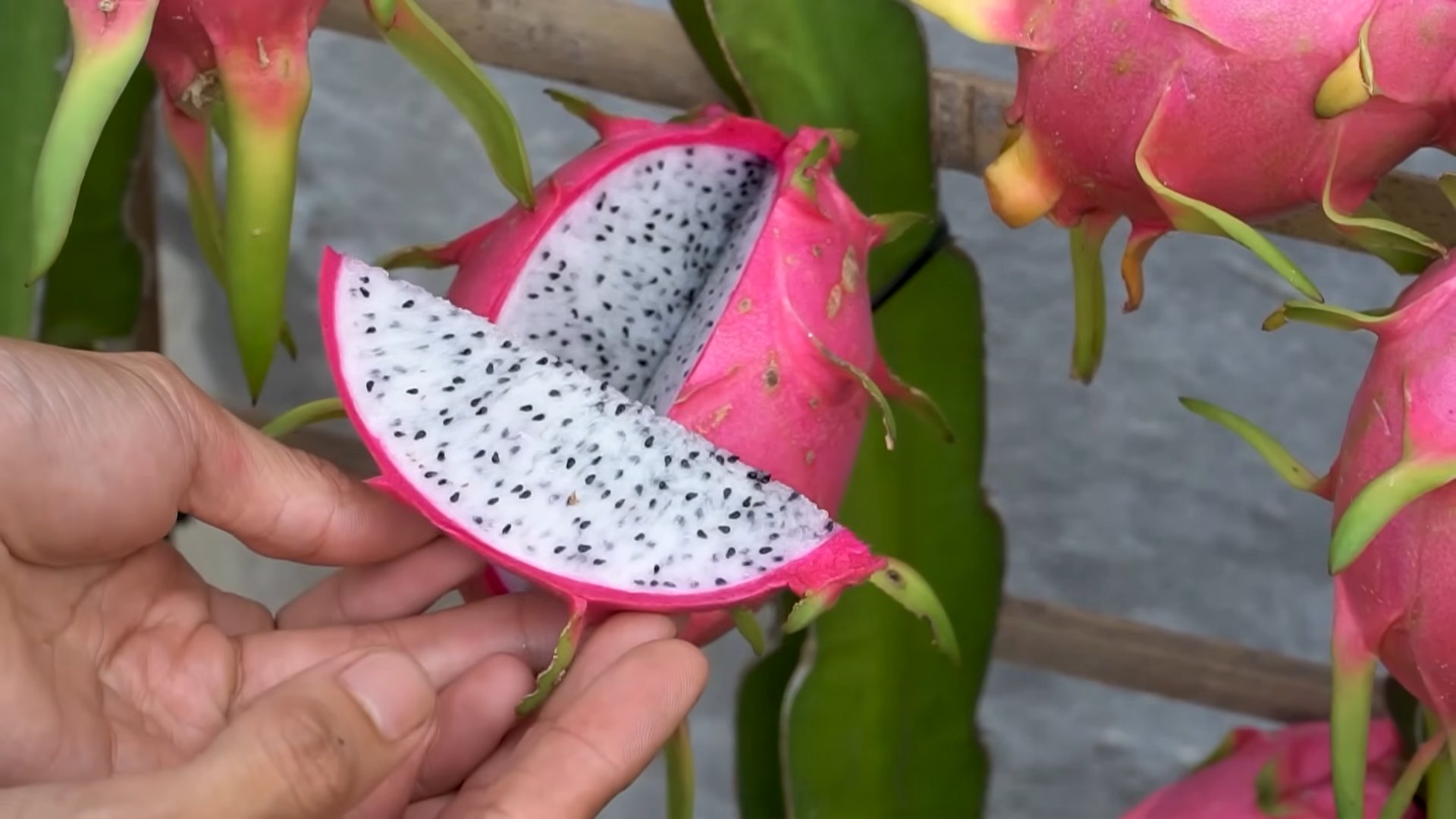
Growing Dragon Fruit at Home: A DIY Guide for Budding Gardeners
Hey there, fellow plant enthusiasts! Ever dreamt of growing your own exotic dragon fruit? Well, dream no more! It’s totally doable, even if you don’t have a sprawling tropical orchard. I’m going to walk you through everything you need to know to cultivate these fascinating fruits right in your own backyard (or even indoors!).
Choosing Your Dragon Fruit Variety
First things first, let’s talk varieties. Dragon fruit, also known as pitaya, comes in several types, each with its own unique flavor and appearance. Here are a few popular choices:
* Hylocereus undatus (White-fleshed): This is the most common variety, known for its white flesh and black seeds. It has a mild, slightly sweet flavor.
* Hylocereus costaricensis (Red-fleshed): This variety boasts vibrant red flesh and a slightly tart taste. It’s a real showstopper!
* Hylocereus megalanthus (Yellow-skinned): This one is a bit rarer, with yellow skin and white flesh. It’s known for its exceptionally sweet flavor.
When choosing a variety, consider your climate and taste preferences. Some varieties are more cold-hardy than others. I personally started with Hylocereus undatus because it’s readily available and relatively easy to grow.
Getting Started: Propagation Methods
You have two main options for starting your dragon fruit journey: seeds or cuttings.
* Seeds: Growing from seeds is a fun experiment, but it takes longer for the plant to mature and produce fruit (usually 5-7 years). Plus, the fruit might not be exactly like the parent plant.
* Cuttings: This is the faster and more reliable method. You’ll get a plant that’s genetically identical to the parent, and it will fruit much sooner (usually 1-3 years).
I highly recommend starting with cuttings. It’s less time-consuming and you’ll get to enjoy those delicious fruits sooner!
Step-by-Step Guide: Propagating Dragon Fruit from Cuttings
Okay, let’s get our hands dirty! Here’s how to propagate dragon fruit from cuttings:
1. Obtain a Healthy Cutting: Find a healthy, mature dragon fruit plant and take a cutting that’s about 12-18 inches long. Make sure the cutting is from a healthy stem, free from diseases or pests. A local nursery or a friend who grows dragon fruit is a great place to source cuttings.
2. Callus the Cutting: This is a crucial step! Allow the cut end of the cutting to callus over for 1-2 weeks. This helps prevent rot when you plant it. Simply place the cutting in a dry, shaded area. You’ll notice the cut end forming a protective layer.
3. Prepare the Potting Mix: Dragon fruit needs well-draining soil. I like to use a mix of cactus potting mix, perlite, and a little bit of compost. This combination provides good drainage and nutrients.
4. Plant the Cutting: Fill a pot (at least 6 inches in diameter) with your prepared potting mix. Insert the calloused end of the cutting about 2-3 inches deep into the soil.
5. Water Sparingly: Water the cutting lightly after planting. Avoid overwatering, as this can lead to rot. Dragon fruit prefers slightly dry conditions.
6. Provide Support: Dragon fruit is a climbing cactus, so it needs support to grow. You can use a stake, trellis, or even a sturdy post. Insert the support into the pot near the cutting.
7. Place in a Sunny Location: Dragon fruit loves sunlight! Place the pot in a location that receives at least 6 hours of direct sunlight per day. If you’re growing indoors, a south-facing window is ideal.
8. Wait and Watch: Be patient! It can take several weeks for the cutting to root. Keep the soil slightly moist, but not soggy. You’ll know it’s rooting when you see new growth emerging from the cutting.
Caring for Your Dragon Fruit Plant
Once your cutting has rooted and started growing, it’s time to provide ongoing care.
* Watering: Water deeply when the soil is dry to the touch. Dragon fruit is drought-tolerant, so it’s better to underwater than overwater. In the winter, reduce watering frequency.
* Fertilizing: Feed your dragon fruit plant with a balanced fertilizer every 2-3 months during the growing season (spring and summer). I like to use a fertilizer specifically formulated for cacti and succulents.
* Pruning: Prune your dragon fruit plant regularly to encourage branching and fruit production. Remove any dead or damaged stems. You can also prune to control the size and shape of the plant.
* Support System: As your dragon fruit plant grows, it will need a strong support system. A sturdy trellis or post is essential. Make sure the support is tall enough to accommodate the plant’s mature size. I use a concrete-filled tire with a sturdy 4×4 post in the center.
* Pest and Disease Control: Dragon fruit is generally pest-resistant, but it can be susceptible to mealybugs and scale. Inspect your plant regularly and treat any infestations promptly. You can use insecticidal soap or neem oil to control pests. Root rot can be a problem if the soil is not well-draining.
Pollination: Helping Nature Along
Dragon fruit flowers are nocturnal, meaning they bloom at night. They’re also self-sterile, which means they need cross-pollination to produce fruit. This is where you might need to lend a helping hand.
* Hand-Pollination: If you don’t have bats or moths in your area to pollinate the flowers, you’ll need to do it yourself. Use a small paintbrush to transfer pollen from one flower to another. The best time to hand-pollinate is at night when the flowers are fully open. I usually do this around 10 PM.
* Attracting Pollinators: Plant flowers that attract bats and moths near your dragon fruit plant. This can help increase pollination rates.
Harvesting Your Dragon Fruit
After successful pollination, it takes about 30-50 days for the fruit to ripen. Here’s how to tell when your dragon fruit is ready to harvest:
* Color Change: The skin of the fruit will change color from green to bright pink or red (depending on the variety).
* Slight Softness: The fruit will feel slightly soft to the touch.
* Easy Detachment: The fruit should detach easily from the stem when gently twisted.
Use a sharp knife or pruning shears to harvest the fruit. Cut the stem close to the fruit.
Growing Dragon Fruit Indoors
Don’t have a backyard? No problem! You can still grow dragon fruit indoors. Here are a few tips for indoor growing:
* Choose a Large Pot: Select a pot that’s at least 12 inches in diameter.
* Provide Plenty of Light: Dragon fruit needs at least 6 hours of direct sunlight per day. If you don’t have enough natural light, use a grow light.
* Maintain Warm Temperatures: Dragon fruit prefers warm temperatures (65-80°F).
* Water Carefully: Avoid overwatering, as this can lead to root rot.
* Provide Support: Use a trellis or stake to support the plant’s growth.
* Hand-Pollinate: Since you won’t have natural pollinators indoors, you’ll need to hand-pollinate the flowers.
Troubleshooting Common Problems
Even with the best care, you might encounter some problems along the way. Here are a few common issues and how to address them:
* Yellowing Leaves: This can be caused by overwatering, underwatering, or nutrient deficiencies. Adjust your watering schedule and fertilize the plant if necessary.
* Root Rot: This is usually caused by overwatering. Make sure the soil is well-draining and avoid letting the plant sit in water.
* Pests: Mealybugs and scale can infest dragon fruit plants. Treat infestations with insecticidal soap or neem oil.
* Lack of Fruit: This can be caused by insufficient pollination, lack of sunlight, or nutrient deficiencies. Hand-pollinate the flowers, provide more sunlight, and fertilize the plant.
Enjoying Your Homegrown Dragon Fruit
Congratulations! You’ve successfully grown your own dragon fruit. Now it’s time to enjoy the fruits of your labor. Dragon fruit can be eaten fresh, added to smoothies, or used in desserts. The possibilities are endless! I personally love to slice it up and eat it straight from the skin. It’s so refreshing and delicious!
Growing dragon fruit is a rewarding experience. It takes patience and care, but the results are well worth it. So, go ahead and give it a try. You might just surprise yourself with your green
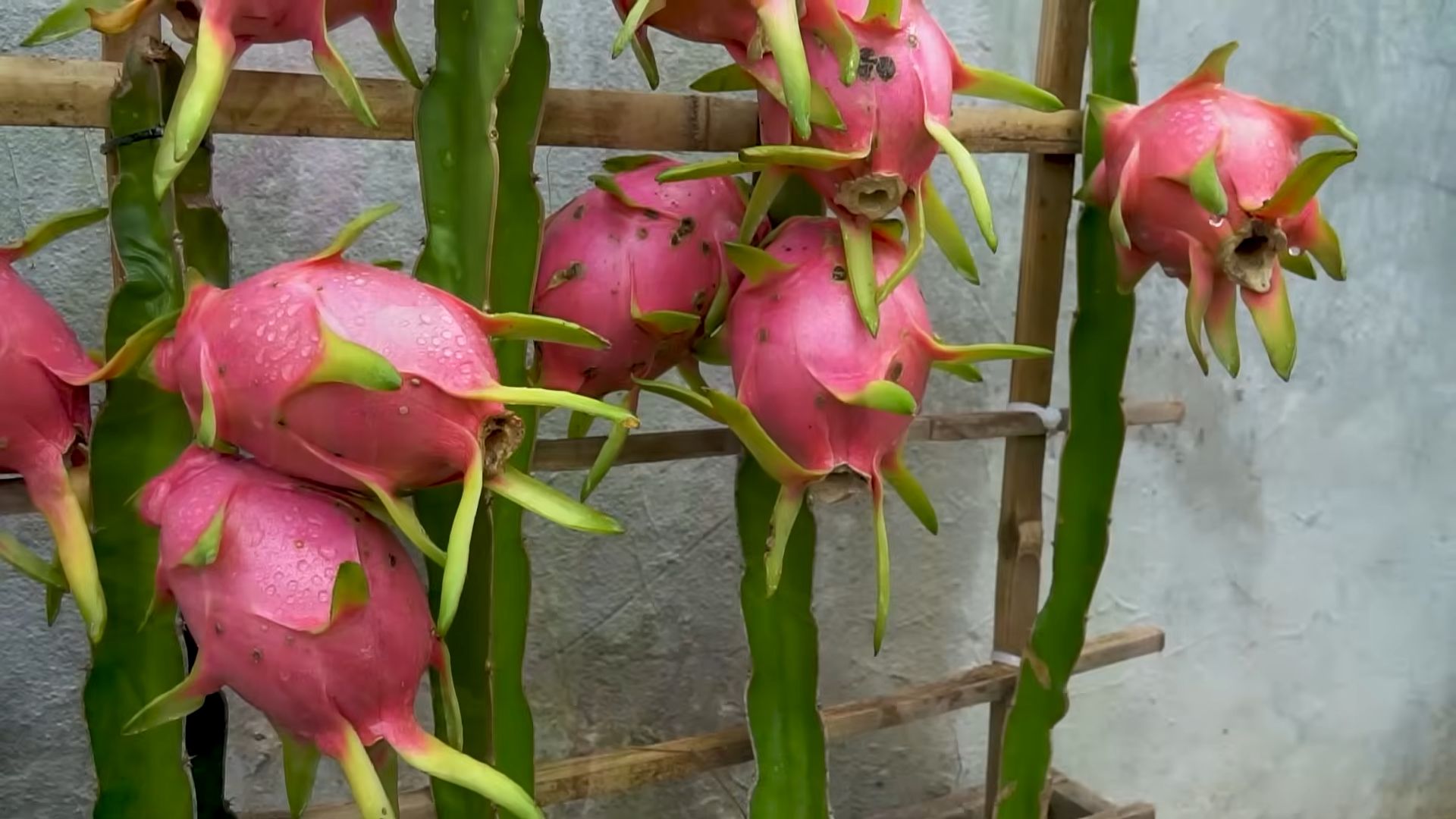
Conclusion
So, there you have it! Growing dragon fruit at home might seem like an exotic endeavor reserved for seasoned gardeners, but with a little patience, the right knowledge, and this simple DIY trick, you can transform your backyard or even your balcony into a thriving dragon fruit oasis. We’ve shown you how to bypass some of the common hurdles and create an environment where your dragon fruit can truly flourish.
Why is this a must-try? Because beyond the sheer satisfaction of nurturing a plant from a small cutting to a fruit-bearing beauty, you’re gaining access to incredibly fresh, delicious, and potentially organic dragon fruit right at your fingertips. Think of the vibrant smoothies, the stunning fruit salads, and the impressive desserts you can create with your homegrown bounty! Plus, you’ll be reducing your carbon footprint by sourcing your fruit locally – from your own garden!
But the benefits don’t stop there. Growing dragon fruit is a rewarding experience that connects you with nature and provides a unique learning opportunity. You’ll gain a deeper understanding of plant life cycles, pollination, and the delicate balance of ecosystems. It’s a fantastic project for families, offering a hands-on educational experience for children and a shared sense of accomplishment.
Looking for variations? Absolutely! Experiment with different dragon fruit varieties. There are white-fleshed, red-fleshed, and even yellow-fleshed dragon fruits, each with its own unique flavor profile. You can also adapt the support structure to suit your space and aesthetic preferences. Consider using a trellis, a sturdy post, or even a repurposed ladder to provide the necessary support for your growing dragon fruit. For those in colder climates, consider growing your dragon fruit in a large pot that can be moved indoors during the winter months. This allows you to enjoy the beauty and bounty of dragon fruit regardless of your geographical location.
Don’t be afraid to get creative with your soil mix. While the recipe we provided is a great starting point, you can adjust the proportions of each ingredient to suit your specific soil conditions and the needs of your plant. Adding compost or other organic matter can further enrich the soil and provide your dragon fruit with the nutrients it needs to thrive.
The key to success with this DIY trick is consistency and observation. Regularly check your plant for signs of pests or diseases, and adjust your watering and fertilization schedule as needed. Remember, every plant is different, so pay attention to the unique needs of your dragon fruit and adapt your care accordingly.
We are confident that with this DIY trick, you’ll be well on your way to enjoying homegrown dragon fruit in no time. So, grab your supplies, get your hands dirty, and embark on this exciting gardening adventure. We can’t wait to hear about your experiences!
We encourage you to try this DIY trick for growing dragon fruit at home and share your results with us. Post pictures of your dragon fruit plants, share your tips and tricks, and let us know what challenges you faced and how you overcame them. Together, we can create a community of dragon fruit enthusiasts and help each other grow the most delicious and beautiful dragon fruit possible. Happy growing!
Frequently Asked Questions (FAQ)
What is the best time of year to start growing dragon fruit?
The best time to start growing dragon fruit is during the spring or early summer. This allows the plant to establish itself and grow vigorously during the warm months. In regions with mild winters, you can potentially start growing dragon fruit year-round, but spring and summer offer the most favorable conditions for growth.
How long does it take for a dragon fruit plant to produce fruit?
Dragon fruit plants typically take 6-18 months to produce fruit from a cutting, provided they are grown under optimal conditions. Factors such as climate, soil quality, watering, and fertilization can all influence the time it takes for a plant to bear fruit. Be patient and consistent with your care, and you’ll be rewarded with delicious dragon fruit in due time.
What kind of soil is best for growing dragon fruit?
Dragon fruit plants thrive in well-draining soil that is rich in organic matter. A good soil mix should consist of a combination of potting soil, compost, and perlite or sand. This will provide the plant with the nutrients it needs while also ensuring proper drainage. Avoid using heavy clay soils, as they can retain too much moisture and lead to root rot.
How often should I water my dragon fruit plant?
Water your dragon fruit plant regularly, especially during the growing season. Allow the soil to dry out slightly between waterings, but avoid letting it dry out completely. Overwatering can lead to root rot, so it’s important to strike a balance. During the winter months, reduce watering frequency as the plant’s growth slows down.
What kind of fertilizer should I use for dragon fruit?
Dragon fruit plants benefit from regular fertilization, especially during the growing season. Use a balanced fertilizer with a ratio of 10-10-10 or 20-20-20. You can also supplement with organic fertilizers such as compost tea or worm castings. Avoid over-fertilizing, as this can damage the plant.
How much sunlight does dragon fruit need?
Dragon fruit plants need at least 6-8 hours of sunlight per day. They thrive in full sun, but can also tolerate partial shade. If you’re growing your dragon fruit indoors, place it near a sunny window or provide supplemental lighting.
How do I pollinate my dragon fruit plant?
Dragon fruit flowers are nocturnal and typically open at night. They are pollinated by bats and moths in their natural habitat. However, if you’re growing dragon fruit at home, you may need to hand-pollinate the flowers to ensure fruit production. Use a small paintbrush to transfer pollen from the stamen (male part) to the pistil (female part) of the flower.
What are some common pests and diseases that affect dragon fruit?
Dragon fruit plants can be susceptible to pests such as aphids, mealybugs, and scale. They can also be affected by diseases such as root rot and fungal infections. Regularly inspect your plant for signs of pests or diseases, and take appropriate action to control them.
How do I prune my dragon fruit plant?
Pruning is essential for maintaining the shape and health of your dragon fruit plant. Remove any dead, damaged, or diseased branches. You can also prune to control the size and shape of the plant. Prune after the plant has finished fruiting.
Can I grow dragon fruit in a pot?
Yes, you can grow dragon fruit in a pot, especially if you live in a colder climate. Choose a large pot with good drainage and use a well-draining soil mix. Provide the plant with a sturdy support structure, such as a trellis or post. Move the pot indoors during the winter months to protect the plant from frost.
What are the different varieties of dragon fruit?
There are many different varieties of dragon fruit, each with its own unique characteristics. Some popular varieties include white-fleshed dragon fruit, red-fleshed dragon fruit, and yellow-fleshed dragon fruit. The flavor and texture of the fruit can vary depending on the variety.
How do I know when my dragon fruit is ripe?
A ripe dragon fruit will have a vibrant color and a slightly soft texture. The skin should be smooth and free of blemishes. You can also gently squeeze the fruit to check for ripeness. If it gives slightly, it’s likely ripe.
How do I store dragon fruit?
Store ripe dragon fruit in the refrigerator for up to a week. You can also freeze dragon fruit for longer storage. Cut the fruit into pieces and place them in a freezer-safe bag or container.
Is growing dragon fruit at home worth the effort?
Absolutely! Growing dragon fruit at home is a rewarding experience that allows you to enjoy fresh, delicious, and potentially organic fruit. It’s also a great way to connect with nature and learn about plant life cycles. With a little patience and the right knowledge, you can successfully grow dragon fruit in your own backyard or balcony.


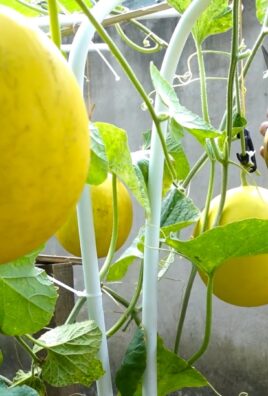
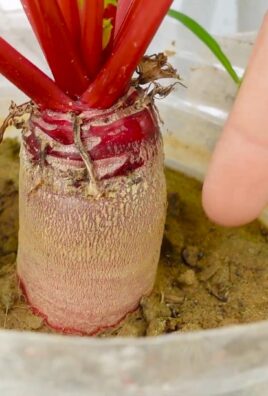
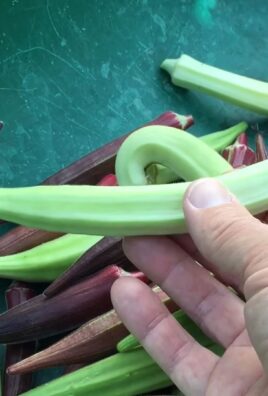
Leave a Comment